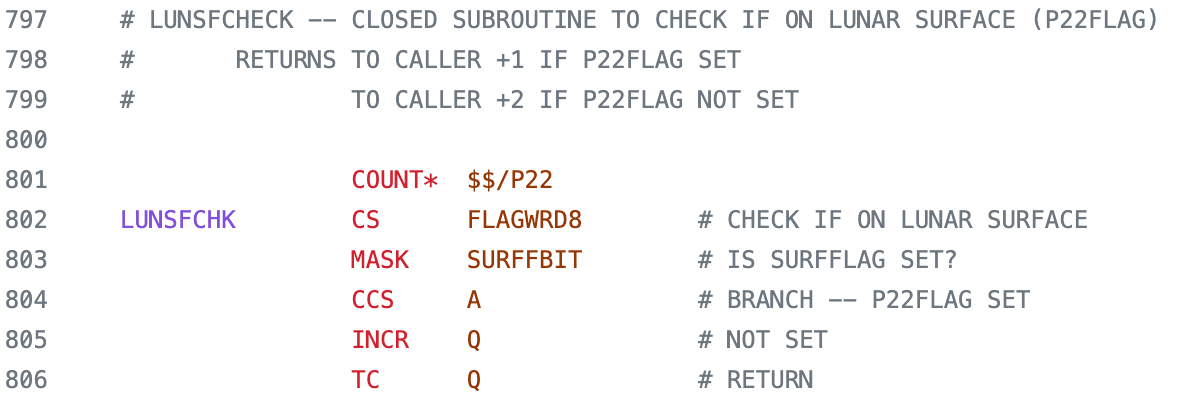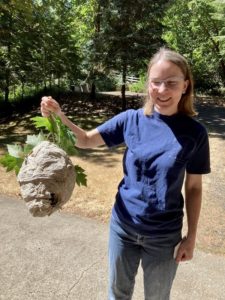August 17th, 2023 at 10:24 pm (Computers, History)
 This iconic image shows Margaret Hamilton standing next to a printout of the flight software that she and her team wrote to control the Apollo Guidance Computer. I recently discovered that the code has been made available via a scan of the printouts, later re-typed as code, and uploaded to GitHub. The code is written in assembly, which consists of individual instructions to load, calculate, and act on data values. Today we use compilers so we can write code in higher-level languages that are easily understandable by humans, but at the time compilers were still pretty new, and the available memory was so limited that they wanted humans to do the optimization at the individual instruction level. Wow!
This iconic image shows Margaret Hamilton standing next to a printout of the flight software that she and her team wrote to control the Apollo Guidance Computer. I recently discovered that the code has been made available via a scan of the printouts, later re-typed as code, and uploaded to GitHub. The code is written in assembly, which consists of individual instructions to load, calculate, and act on data values. Today we use compilers so we can write code in higher-level languages that are easily understandable by humans, but at the time compilers were still pretty new, and the available memory was so limited that they wanted humans to do the optimization at the individual instruction level. Wow!
Here’s an example excerpt from the code. Even if you don’t know AGC assembly (I don’t), it’s possible to follow along due to the excellent comments.

I’m in awe of how this massive software engineering project would have proceeded (How did they test it? And without modern version control… did they use periodic printouts in case they found a mistake and wanted to roll back?) What an inspiring project!
Browsing the open issues on the project, they seem dedicated to increasing the quality of the content by carefully proofreading it against the original scans of the code printouts. What a labor of love :) But what a wonderful piece of programming history!
Comments
August 10th, 2023 at 6:04 pm (Animals)
The other day, I discovered an enormous wasp nest (about 14″ in diameter) in a tree next to my house:
The next morning, Google helped me discover Dan Scollard, who comes out to remove wasps from homes, humanely “sends them to sleep” in a cooler full of dry ice, then donates them to a lab that extracts the venom for use in allergy shots. (!)
When he arrived, he said, “Oh, that’s a beauty. A lot of people say they found a nest as big as a basketball, but yours actually IS.”
My nest was constructed and occupied by the bald-faced hornet (which apparently is actually a wasp). Dan told me all about this wasp; he has a real admiration for them. I highly recommend reading about their life cycle and also viewing Dan’s photo gallery! These wasps are a useful part of nature, but risky to have next to your door where you (or unwitting visitors) could be suddenly attacked. Apparently this wasp can be quite aggressive and territorial.
Dan put on all of his gear, then vacuumed up all of the wasps around the nest, waited a bit for more wasps to come home from hunting, did a second vacuuming pass, and clipped the nest from the branch to remove it. He said it would hang it in his backyard so the queen (who had not emerged) could “live out the rest of her days in peace.” He said I could hold the nest with its lurking queen: gosh wow!

What an amazing experience! It’s a joy to meet knowledgeable people who love their subject and use their knowledge to do good in the world. I’m much happier sending these wasps out to help people avoid severe reactions, and the process was so much better than dousing the nest with poison. Thank you, Dan!
1 Comments
1 of 1 people learned something from this entry.
 This iconic image shows Margaret Hamilton standing next to a printout of the flight software that she and her team wrote to control the Apollo Guidance Computer. I recently discovered that the code has been made available via a scan of the printouts, later re-typed as code, and uploaded to GitHub. The code is written in assembly, which consists of individual instructions to load, calculate, and act on data values. Today we use compilers so we can write code in higher-level languages that are easily understandable by humans, but at the time compilers were still pretty new, and the available memory was so limited that they wanted humans to do the optimization at the individual instruction level. Wow!
This iconic image shows Margaret Hamilton standing next to a printout of the flight software that she and her team wrote to control the Apollo Guidance Computer. I recently discovered that the code has been made available via a scan of the printouts, later re-typed as code, and uploaded to GitHub. The code is written in assembly, which consists of individual instructions to load, calculate, and act on data values. Today we use compilers so we can write code in higher-level languages that are easily understandable by humans, but at the time compilers were still pretty new, and the available memory was so limited that they wanted humans to do the optimization at the individual instruction level. Wow!
